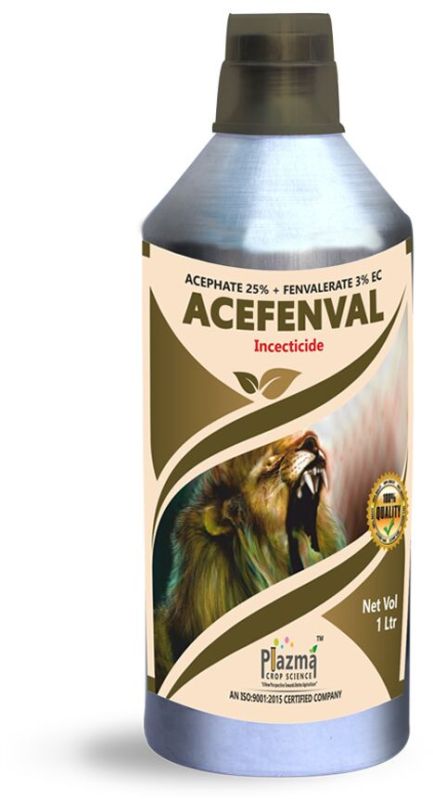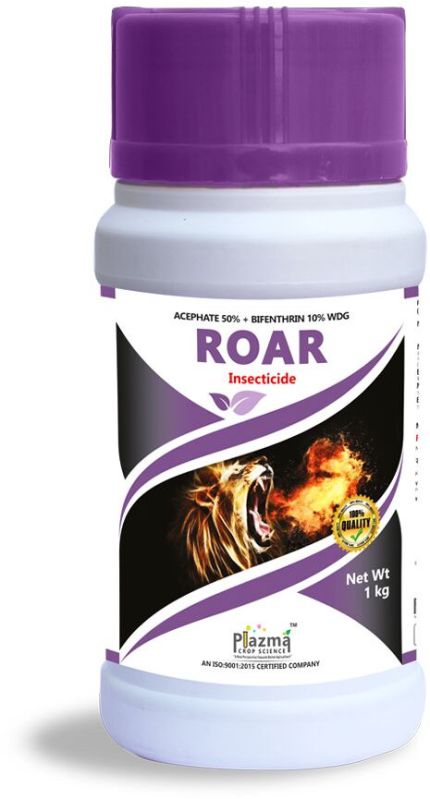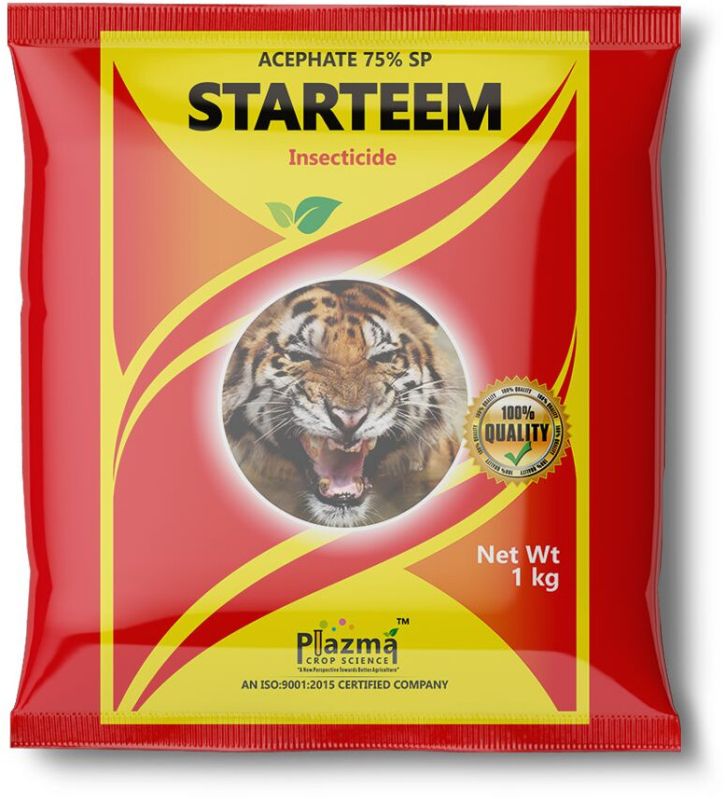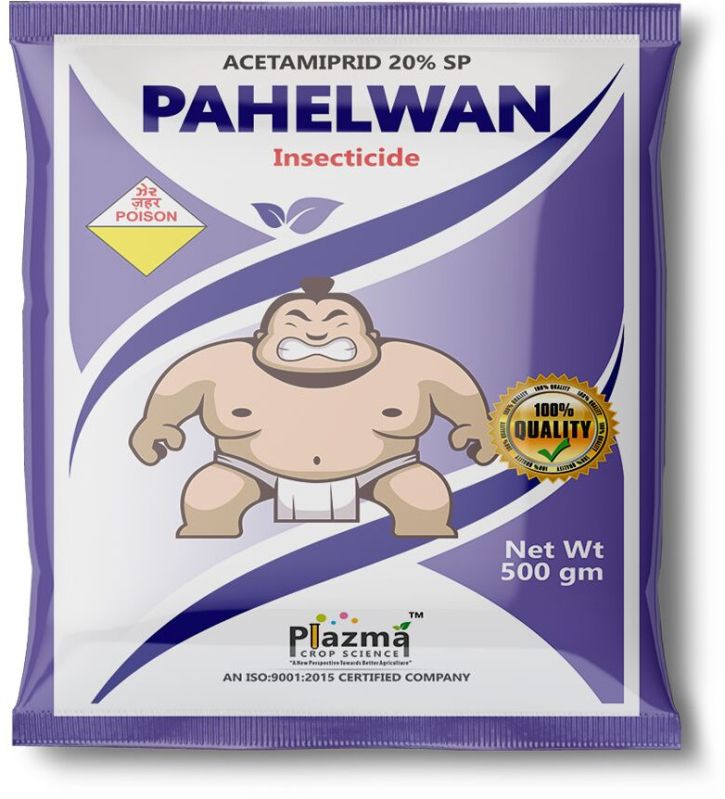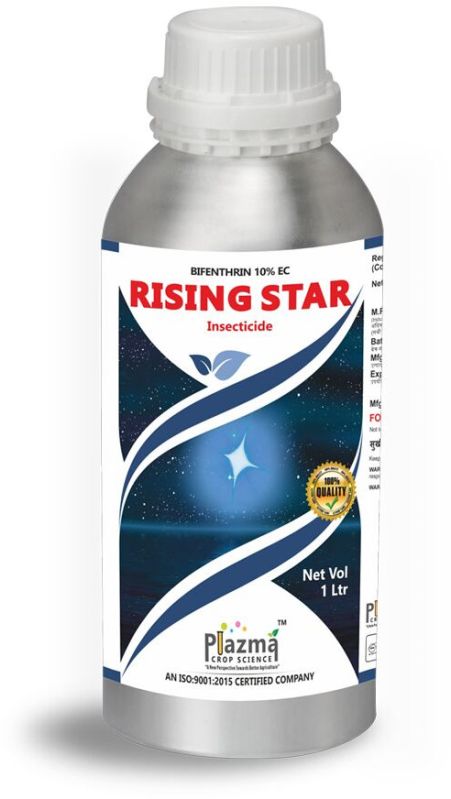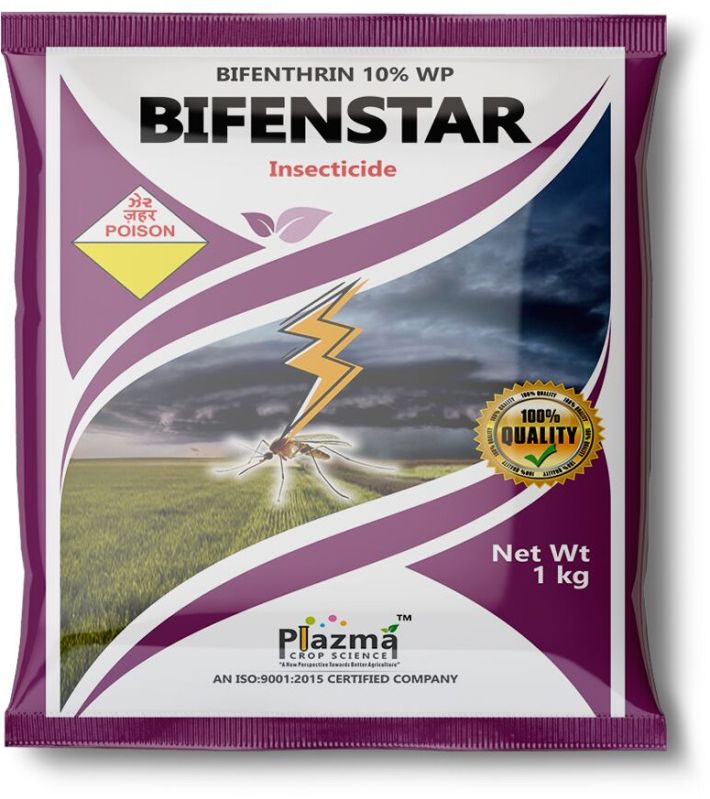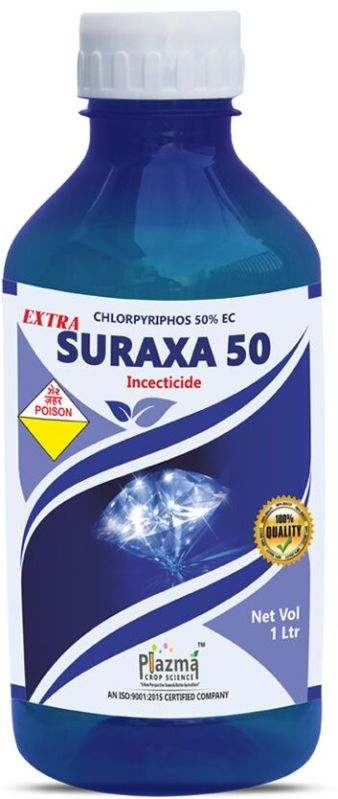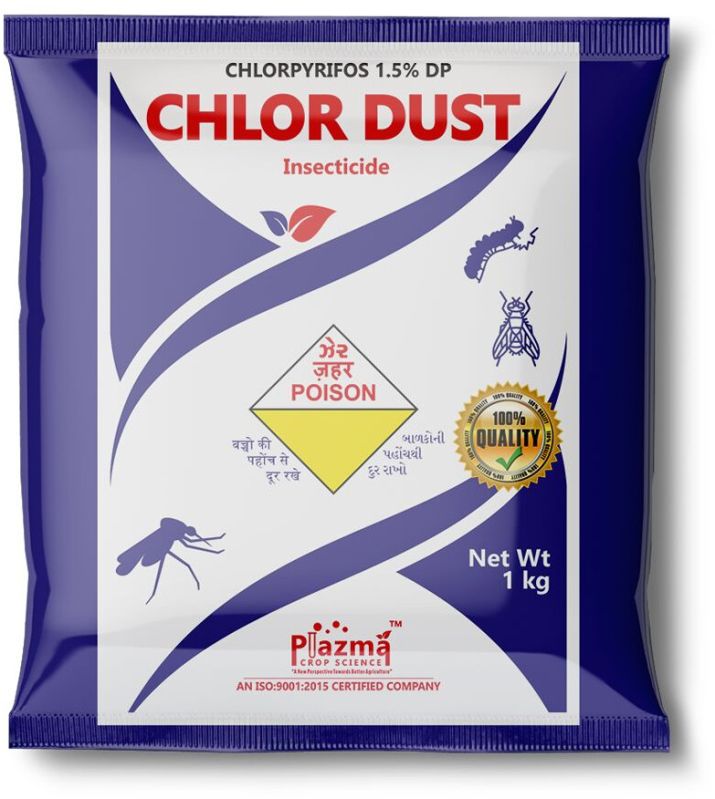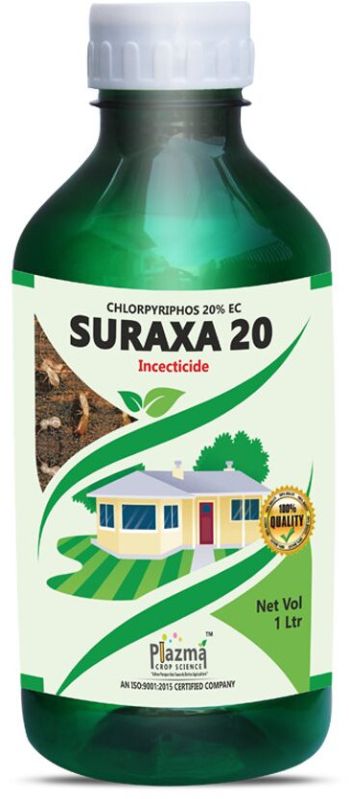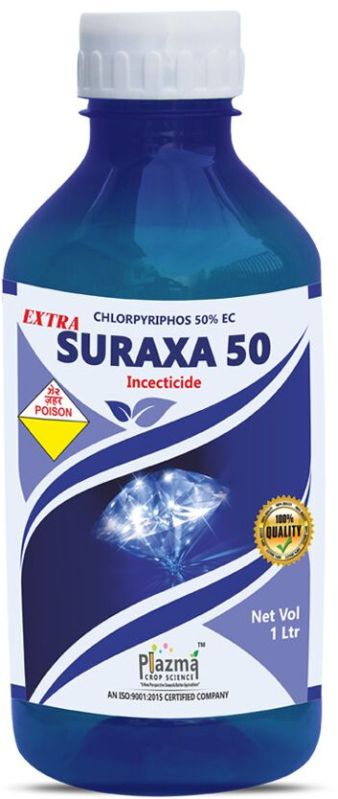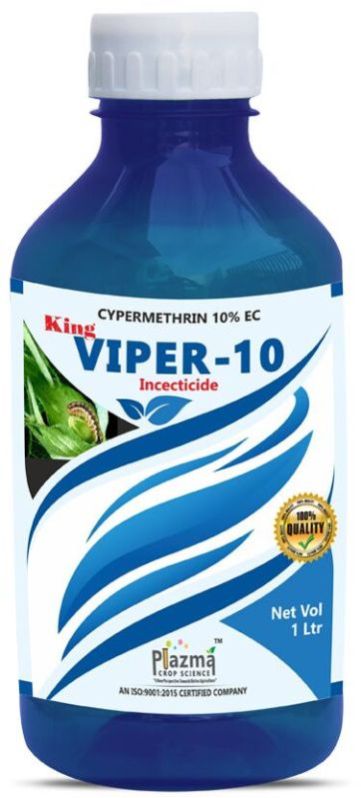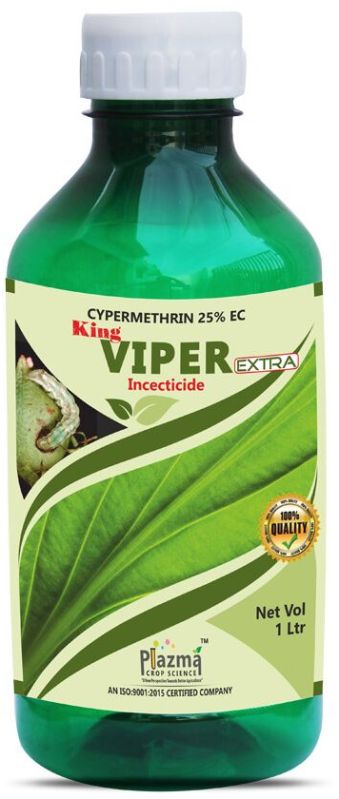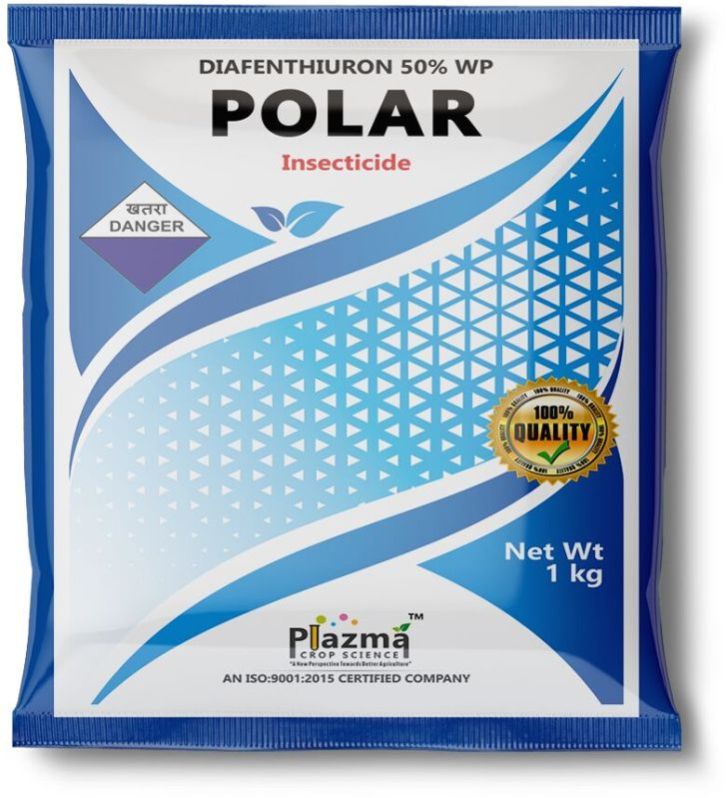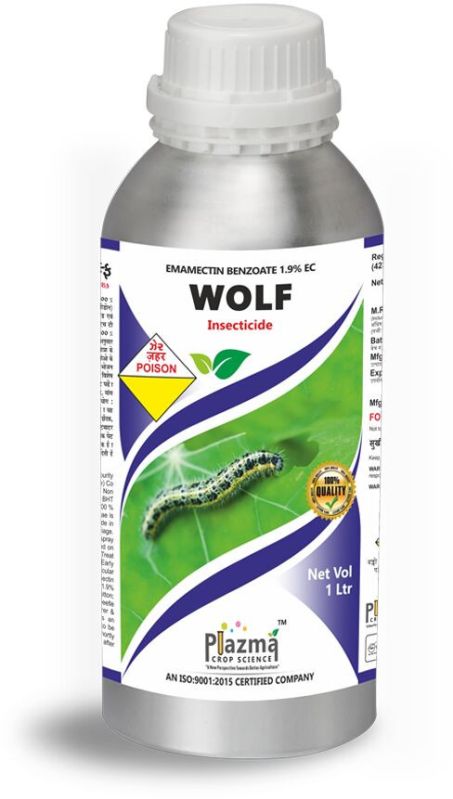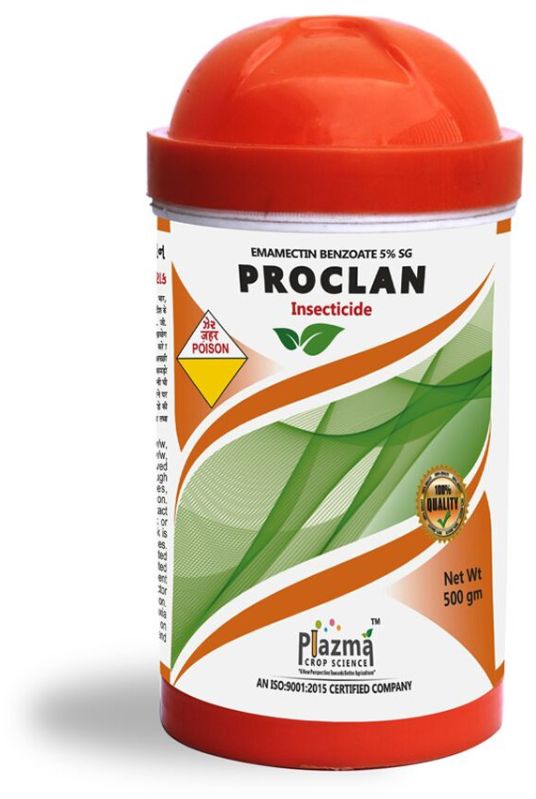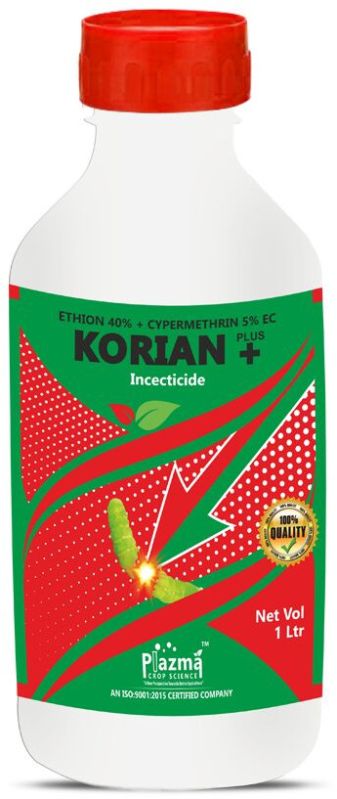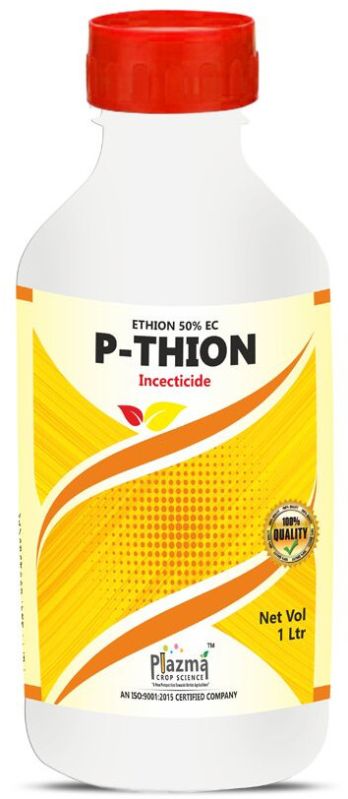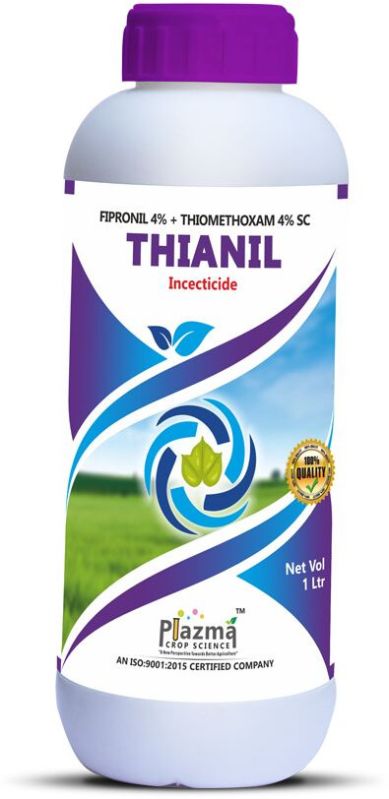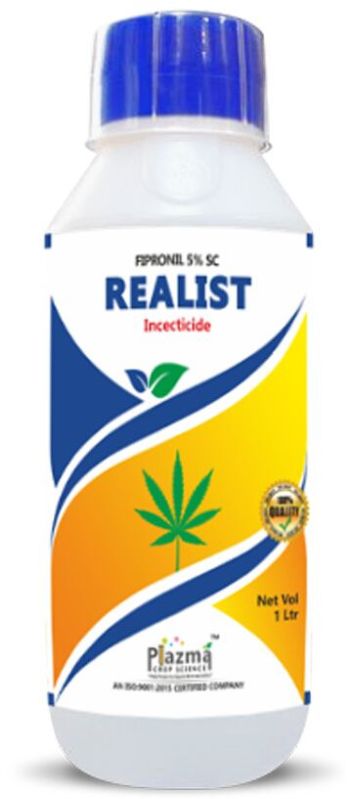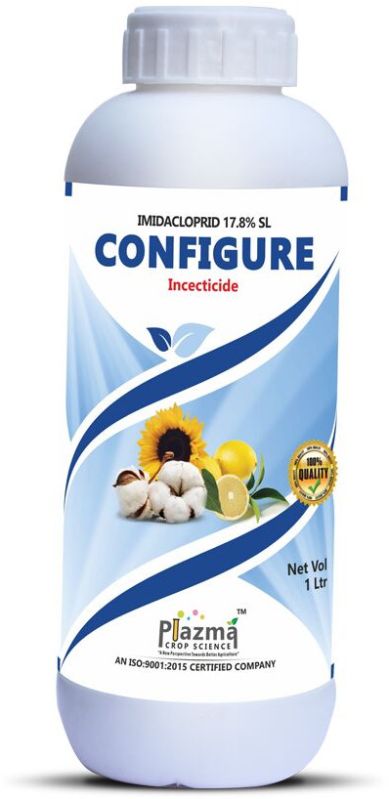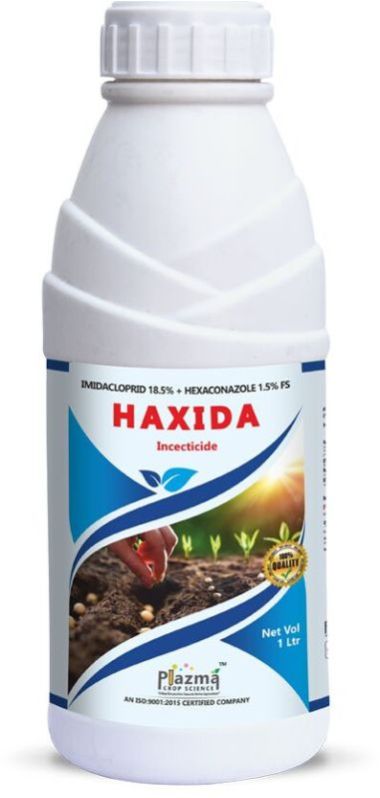- View Mobile Number
plazmacropscience@gmail.com
Insecticides
Leading Manufacturers and Wholesaler of Acephate 25% + Fenvalerate 3% E.C. Insecticide, Acephate 50% + Bifenthrin 10% WDG Insecticide, Acephate 75% SP Insecticide, Acephate 95% SG Insecticide, Acetamiprid 20% SP Insecticide, Bifenthrin 10% EC Insecticide, Bifenthrin 10% WP Insecticide, Chlorpyrifos 50% E.C. Insecticide, Chlorpyriphos 1.5% D.P Insecticide, Chlorpyriphos 20% E.C Insecticide, Chlorpyriphos 50% + Cypermethrin 5% EC Insecticide, Cypermethrin 10% E.C. Insecticide, Cypermethrin 25% E.C. Insecticide, Diafenthiuron 50% WP Insecticide, Emamectin Benzoate 1.9% EC Insecticide, Emamectin Benzoate 5% SG Insecticide, Ethion 40% + Cypermethrin 5% EC Insecticide, Ethion 50% EC Insecticide, Fipronil 4% + Thiamethoxam 4% SC Insecticide, Fipronil 5% SC Insecticide, Imidacloprid 17.8% SL Insecticide and Imidacloprid 18.5% + Hexaconazole 1.5% FS Insecticide from Bhavnagar.
| Business Type | Manufacturer, Supplier |
| Brand Name | Plazma Crop Science |
| Application | Agriculture |
| Purity | 100% |
| Packaging Type | Plastic Bottle |
| Packaging Size | 1 Ltr. |
| Country of Origin | India |
| State | Liquid |
| Technical Name | Acephate 25% + Fenvalerate 3% E.C. |
| Generic Name | Acefenval |
| Shelf life | 1 Year |
Acephate 25% + Fenvalerate 3% EC is used for the control of American bollworm and sucking pests on cotton.
* Caution :- It is toxic to honey bees, spray application should be avoided during the foraging period of bees
Direction of UseKnapsack sprayer, foot sprayer, compression knapsack sprayer, compression knapsack battery sprayer and ASPEE-HTP power sprayer.
Time of Application-
Precaution- Keep away from foodstuffs, empty foodstuff containers and animals food.
- Avoid contact with mouth, eyes and skin
- Avoid inhalation the spray mist. Spray in the direction of wind.
- Wash thoroughly the contaminated clothes and parts of the body after spraying.
- Do not smoke, drink, eat and chew anything while spraying.
- Wear full protective clothing while mixing and spraying.
Anorexia, headache, dizziness, anxiety, miosis, impairment of visual acuity, abdominal cramps, muscular tremors, diarrhoea, respiratory difficulty, nausea, vomiting,allergies, excessive sweating lacrimation and salivation may occur.
First Aid- If swallowed, donot induce vomiting or give any liquid orally..
- If clothing and skin is contaminated, remove the clothes and wash the contaminated skin with copious amount of soap and water.
- If eyes are contaminated, flush with plenty of saline/clean water for about 10 to 15 minutes.
- If inhaled, remove the patient to fresh air
The product is not phytotoxic when used as per field recommendation.
Antidote- Atropinize the patient immediately and maintain full atropinization by repeated doses of 2 to 4 mg. of atropine sulphate intravenously at 5 to 10 minutes interval. As much as 25 to 50 mg. of atropine may be required in a day. The need for further atropine administration is guided by the continuance of symptoms. Extent of salivation is a useful criterion for dose adjustment.
- Dissolve 1-2 gm of 2 PAM in 10 ml distilled water and inject intravenously very slowly for 10-15 minutes.
- Antihistamines may be given to control allergies.
- Packaging or surplus materials and washings from the machines and container s shall be disposed of in a safe manner so as prevent environmental or water pollution.
- The used packages shall nto be left outside to prevent their re-use.
- Packages shall be brokent and buried away from habitation.
- The packages containing the insecticides shall be stored in separate rooms or premises away from teh rooms or premises used for storing other articles particularly food articles or shall be kept in separate almirahs under lock and key depending on the quantity and the nature on the insecticide.
- The room should be well built well lit, ventilated and sufficient in dimensions. The conditions of the store should be dry and cool.
| Business Type | Manufacturer, Supplier |
| Brand Name | Plazma Crop Science |
| Application | Agriculture |
| Purity | 100% |
| Packaging Type | Plastic Bottle |
| Packaging Size | 1 Kg |
| State | Powder |
| Country of Origin | India |
| Technical Name | Acephate 50% + Bifenthrin 10% WDG |
| Generic Name | Roar |
Acephate 50% and Bifenthrin 10% is a wettable graules containing Acephate 50% a.i. and Bifenthrin 10% a.i. in the formulation. It is used for control of Leaf hopper, Aphid, Thrips & Bollworms on Cotton crop.
* Caution :- It is toxic to honey bees, spray application should be avoided during the foraging period of bees.
Direction of UseThe required quantity of ready mix formulation Acephate + Bifenthrin was diluted in water and sprayed by using hands operated knapsack sprayer @800g/ha.
Time of ApplicationEquipment used in the application: Use knapsack sprayer fitted with hollow cone nozzle for spray.
Precaution- Avoid inhalation and contact with skin and eyes.
- Keep away from children, foodstuffs, animals feed, heat and flame. Store in a cool and dry place under lock and key.
- Do not mix the insecticides with bare hands.
- Do not eat, drink, smoke or chew tobacco while spray.
- Spray the insecticides only in the direction of wind blowing and not against it so as to prevent the setting of the drift on body.
- The user should use full protective clothing with rubber gloves, boots. Face should be covered with face shield or dust mask and body should be covered with an overall rubber apron and hood or hat.
- Do not use as an ultra low volume spray.
Headache, giddiness, vertigo, nausea, vomiting, blurred vision, diarrhoea, convulsions, excessive sweating, lacrimation and salivation may occur. Rashes numbing, burning or tingling.
First AidWash the contaminated skin thoroughly with soap and plenty of water. Remove the contaminated clothing. If swallowed induce vomiting by tickling the back of throat. If eyes are contaminated, flush the eyes with plenty of fresh water for at least 10 minutes. Remove the patient into fresh air.
Antidote- Atropinize the patient immediately and maintain full atropinization by repeated doses of 2 to 4 mg. of atropine sulphate intravenously at 5 to 10 minutes interval. As much as 25 to 50 mg. of atropine may be required in a day. The need for further atropine administration is guided by the continuance of symptoms. Extent of salivation is a useful criterion for dose adjustment.
- Dissolve 1-2 gm of 2 PAM in 10 ml distilled water and inject intravenously very slowly for 10-15 minute.
- The packages shall be broken and buried away from habitation.
- The used packages shall not be left outside to prevent their re-use.
- Packages or surplus material and washings should be disposed off in a safe manner so as to prevent environment or water pollution.
- The packages containing the insecticides shall be stored in separate rooms or premises away from rooms or premises used for storing the other articles or shall be kept in separate almirahs under lock and key depending upon the quantity and nature of the insecticide.
- The rooms or the premises meant for storing the insecticides, shall be well built, well lit, well ventilated and sufficient dimensions to avoid contamination with vapors.
| Business Type | Manufacturer, Supplier |
| Brand Name | Plazma Crop Science |
| Application | Agriculture |
| Purity | 100% |
| Packaging Type | Plastic Packet |
| Packaging Size | 1 Kg |
| Country of Origin | India |
| State | Powder |
| Technical Name | Acephate 75% SP |
| Generic Name | Starteem |
| Shelf life | 1 Year |
It is a soluble powder containing Acephate ingredient 75% w/w and balance other relevant ingredients. It is used to control Jassids and bollworms on cotton, Aphid on safflower and stem borer, leaf folder, plant hopper & GLH on Paddy.
* Caution :- It is toxic to honey bees, spray application should be avoided during the foraging period of bees.
Direction of UseKnapsack sprayer, foot sprayer, compression knapsack sprayer, compression knapsack battery sprayer and ASPEE-HTP power sprayer.
Precaution- Keep away from foodstuffs, empty foodstuff containers and animals feed.
- Avoid contact with mouth, eyes and skin.
- Avoid inhalation the spray mist. Spray in the direction of wind.
- Wash thoroughly the contaminated clothes and parts of the body after spraying.
- Do not smoke, drink, eat and chew anything while spraying.
- Wear full protective clothing while mixing and spraying.
Headache, giddiness, vertigo,nausea, vomiting, blurred vision, diarrhoea, convulsions, excessive sweating, lacrimation and salivation may occur.
First Aid- If swallowed, induce vomiting by tickling the back of throat. Repeat it until the vomitus is clear. Do not induce vomiting if the patient is unconscious.
- If clothing and skin are contaminated, remove the cloths and wash the contaminated skin with copious amount of soap and water.
- If eyes are contaiminated, flush with plenty of saline/clean water for about 10 to 15 minutes.
- If inhaled, remove the patient to fresh air.
The product is not phytotoxic, When used as per field recommendation.
Antidote- Atropinize the patient immediately and maintain full atropinization by repeated doses of 2 to 4 mg. of atropine sulphate intravenously at 5 to 10 minutes interval. As much as 25 to 50 mg. of atropine may be required in a day. The need for further atropine administration is guided by the continuance of symptoms. Extent of salivation is a useful criterion for dose adjustment.
- Dissolve 1-2 gm of 2 PAM in 10 ml distilled water and inject intravenously very slowly for 10-15 minutes.
- It shall be the duty of manufactures formulators of herbicide and operator to dispose packages or surplus materials and washings from the machine and container shall be disposed off in a safe manner so as to prevent environmental and water. pollution.
- The used packages shall not be left outside to prevent their re-use.
- Packages shall be broken and burried away from habitation.
- The packages containing the insecticides shall be stored in separate rooms or premises away from the rooms or premises used for storing other articles or shall be kept in separate almirah under lock and key depending upon the quantity and nature of the insecticide
- The rooms or premises meant for storing the insecticides shall be well built, dry, well-lit, ventilated and of sufficient dimensions to avoid contamination with vapours
| Business Type | Manufacturer, Supplier |
| Application | Agriculture |
| Brand Name | Plazma Crop Science |
| Purity | 95% |
| State | Powder |
| Country of Origin | India |
| Packaging Type | Plastic Bottle |
| Packaging Size | 1 Kg |
| Technical Name | Acephate 95% SG |
| Generic Name | Hulk 95 |
Acephate 95% SG is an organo phosphorus insecticide used for the control of stem borer, leaf folder and brown plant hoppers on Paddy, Jassid on Cotton and Thrips, Aphids and fruit borer (H. armigera) on Chilli.
* Caution :- It is toxic to honey bees, spray application should be avoided during the foraging period of bees.
Direction of Use
- Preparation of spray solution: Take the required quantity of formulation, dilute with little water and stir well using a stick. Then add the remaining quantity of water as per spray volume required and mix well again by stirring.
- Plant Protection equipment: Use knapsack sprayer, foot sprayer, compression knapsack sprayer, compression knapsack battery sprayer as ASPEE-HTP sprayer.
Precaution
- Keep away from foodstuffs, empty foodstuff containers and animals food.
- Avoid contact with mouth, eyes and skin.
- Avoid inhalation the spray mist. Spray in the direction of wind.
- Wash thoroughly the contaminated clothes and parts of the body after spraying.
- Do not smoke, drink, eat and chew anything while spraying.
- Wear full protective clothing while mixing and spraying.
Symptoms Of Poisoning
The early symptoms may be combination of headache, giddiness, vertigo, nausea, vomiting blurred vision, sweating, excessive lacrimation and salivation.
First Aid
- Gastric lavage with 5% sodium bicarbonate may be given if swallowed.
- Wash contaminated skin and irrigate eyes with normal saline.
Phytotoxicity
Acephate 95% SG is not phytotoxic when used as per recommendations.
Antidote
- Atropinise the patient immediately and maintain full atropinization by repeated doses of 2 to 4 mg at 5 minutes to 10 minutes interval for hours together. The need for further atropine administration is indicated by the continanue of symptoms. As much as 24 to 50 mg may be required in a day. The extent of salivation is a useful criterion to follow in a adjusting the dosages of atropine.
- Administere 1-2 gm of 2-pyridine-2-aldozine-N-methyl-odine (2 P.A.M) diluted in 10 cc of distilled water and injected intraventously very slowly taking 10 to 15 minutes.
Disposal Of Used Container
- Packages or surplus material and washings from the machines and containers shall be disposed off in a safe manner so as to prevent environment and water pollution.
- The used packages shall not be left outside to prevent their re-use.
- The packages shall be broken and buried away from the habitation.
Storage Conditions
- The packages containing the insecticides shall be stored in separate rooms or premises away from the room or premises used for storing other articles particularly food articles or shall kept in separate almirahs under lock and key depending upon the quantity and nature of the insecticides.
- The store room should be well built, well lit, ventilated and of sufficient dimension. The condition of the store should be dry and cool.
| Business Type | Manufacturer, Supplier |
| Brand Name | Plazma Crop Science |
| Application | Agriculture |
| Purity | 100% |
| Packaging Type | Plastic Packet |
| Packaging Size | 500gm |
| Country of Origin | India |
| Technical Name | Acetamiprid 20% SP |
| Generic Name | Pahelwan |
| State | Powder |
| Shelf life | 1 Year |
Acetamiprid 20% SP is a soluble powder formulation containing 20% of the active ingredient Acetamiprid. Acetamiprid 20% SP is a highlyeffective systemic insecticide for the control of aphids, jasssids and whiteflies in cotton crop; Aphid in Cabbage; Aphid in Okra.
Direction of UseKnapsack sprayer, foot sprayer, compression knapsack sprayer, compression knapsack battery sprayer and ASPEE-HTP power sprayer.
Precaution- Keep away from foodstuffs, empty foodstuff containers and animals food.
- Avoid contact with mouth, eyes and skin.
- Avoid inhalation the spray mist. Spray in the direction of wind.
- Wash thoroughly the contaminated clothes and parts of the body after spraying.
- Do not smoke, drink, eat and chew anything while spraying.
- Wear full protective clothing while mixing and spraying.
Nausea, vomiting, headache, dizziness and stomach-ache may occur.
First Aid- If swallowed, induce vomiting by tickling the back of throat. Repeat it until the vomitus is clear. Do not induce vomiting if the patient is unconscious.
- If clothing and skin are contaminated remove the clothes and wash the contaminated skin with copious amount of soap and water.
- If eyes are contaiminated, flush with plenty of saline/clean water for about 10 to 15 minutes.
- If inhaled, remove the patient to fresh air.
The product is not phytotoxic when used as per field recommendation.
AntidoteNo specific antidote is known. Treat symptomatically.
Disposal Of Used Container- Empty containers shall be broken and burried away from habitation
- The used containers or package shall not be left outside to prevent their re-use
- The package or surplus material and washing should be disposed off in a safe manner so as to prevent environmental and water pollution
- The packages containing the insecticides shall be stored in separate rooms or premises away from the rooms or premises used for storing other articles or shall be kept in separate almirah under lock and key depending upon the quantity and nature of the insecticide
- The rooms or premises meant for storing the insecticides shall be well built, dry, well-lit, ventilated and of sufficient dimensions to avoid contamination with vapours
| Business Type | Manufacturer, Supplier |
| Brand Name | Plazma Crop Science |
| Application | Agriculture |
| Packaging Type | ALUMINIUM BOTTLE |
| Packaging Size | 1 Ltr. |
| State | Liquid |
| Country of Origin | India |
| Technical Name | Bifenthrin 10% EC |
| Generic Name | Rising Star |
Bifenthrin 10% EC is a broad spectrum insecticide having contact and stomach action against bollworm and sucking pest white fly in Cotton and leaf folder, green leaf hopper & stem borer in Rice, termite in Sugarcane. It contains 10% w/w active ingredient Bifenthrin with other relevant ingredients.
* Caution :- It is toxic to honey bees, spray application should be avoided during the foraging period of bees. Toxic to aquatic organisms hence should not be used near water bodies, aquaculture or pisciculture.
Direction of Use
- DIRECTION FOR USE: Take the measured quantity of Bifenthrin 10% EC, add to it a small quantity of water, mix thoroughly and then add the remaining quantity of water while stirring vigorously. Do not spray facing the wind.
- EQUIPMENT USED IN APPLICATION: Knapsack sprayer, Knapsack power sprayer, motorized Knapsack sprayer cum duster, compression Knapsack sprayer, compression Knapsack battery sprayer, wheel barrow sprayer and HTP power sprayer.
- Precaution
- Avoid inhalation and contact with skin and eyes.
- Keep away from children, food stuffs, animals feeds, heat and flame. Store in a cool place under lock and key.
- Do not mix the insecticide with bare hands.
- Do not eat, drink, smoke or chew tobacco while spray.
- Spray the insecticide only in the direction of wind blowing and not against it so as to prevent the setting of the drifts on body.
- The user should use full protective clothing with rubber gloves, boots. Face should be covered with face shield or dust mask and body should be covered with an overall or rubber apron and hood or hat.
- Do not use as an ultra low volume spray.
- Should not be sprayed near water bodies.
- It should not be used in the areas where pisciculture/auqaculture is practised.
Effects from overexposure result from either swallowing, inhaling or coming into contact with the eyes or skin. Symptoms of overexposure include bleeding from the nose, tremors and convulsions. Contact with this product may occassionaly produce skin sensations such as rashes, numbing, burning or tingling. These skin sensations are reversible and usally subside within 12 hours.
First Aid - If inhaled remove the patient into fresh air. If breathing difficulty or discomfort occurs and persists, obtain medical attention.
- Rinse mouth with water. Dilute by giving 1 or 2 glasses of water. Never give anything by mouth to an unconscious person. See a medical doctor immediately.
- Remove contaminated clothes, wash contaminated skin and clothes with soap and plenty of water. Get medical attention if irritation occurs and persists.
- If eyes are contaminated, wash for 15 minutes with clean water.
- Antidote
Treat symptomatically and supportively.
Disposal Of Used Container- It shall be the duty of manufacturers, formulators of insecticides and operators to dispose packages or surplus materials and washing in a safe manner so as to prevent environmental or water pollution.
- The used packages shall not be left outside to prevent their re-use.
- The packages shall be broken and buried away from habitation.
- The package containing insecticides shall be stored in separate rooms or premises away from the rooms or premises used for storing other articles or shall be kept in separate almirahs under lock and key depending upon the quantity and nature of the insecticides.
- The rooms or premises means for storing insecticides shall be well built, dry, well-lit and ventilated and of sufficient dimension to prevent environmental contamination with vapour of insecticide.
| Business Type | Manufacturer, Supplier |
| Brand Name | Plazma Crop Science |
| Purity | 100% |
| Packaging Type | Plastic Packet |
| Packaging Size | 1 Kg |
| Country of Origin | India |
| State | Powder |
| Technical Name | Bifenthrin 10% WP |
| Generic Name | Bifenstar |
Bifenthrin 10% WP is a broad spectrum insecticide containing active ingredent 10% w/w Bifenthrin. A highly effective public health insecticide for control of adult mosquito. NOT TO BE USED ON ANY FOOD CROPS.
* Caution :- It is toxic to honey bees, spray application should be avoided during the foraging period of bees. Toxic to aquatic organisms hence should not be used near water bodies, aquaculture or pisciculture.
Direction of UseApply thoroughly on all surfaces covering dark corners and hidden places where mosquitoes rest. EQUIPMENT FOR USAGE: Foot stir-ip pump, knapsack and Domestic hand sprayer.
Precaution- Avoid raising a dust cloud.
- Wear overalls, gloves, boots and face shild during application and avoid exposure to the spray.
- Do not inhale atomized spray, aviod eyes and skin contact.
- Do not eat, drink or smoke while spraying.
- Do not spray on foodstuffs, utensils, birdcages, pets or human.
- Wash hands and other exposed parts of the body with ample water and soap.
- In case of accident call the physician.
- Should not be sprayed near water bodies.
Effects from overexposure result from either swallowing, inhaling or coming into contact with the eyes or skin. Symptoms of overexposure include bleeding from the nose, tremors and convulsions. Contact with this product may occassionaly produce skin sensations such as rashes, numbing, burning or tingling. These skin sensations are reversible and usally subside within 12 hours.
First Aid- If inhaled remove the patient into fresh air. If breathing difficulty or discomfort occurs and persists, obtain medical attention.
- Rinse mouth with water. Dilute by giving 1 or 2 glasses of water. Never give anything by mouth to an unconscious person. See a medical doctor immediately.
- Remove contaminated clothes, wash contaminated skin and clothes with soap and plenty of water. Get medical attention if irritation occurs and persists.
- If eyes are contaminated, wash for 15 minutes with clean water.
- Antidote
-
There is no specific antidote. Treat symptomatically
Disposal Of Used Container- It shall be the duty of manufacturers, formulators of insecticides and operators to dispose packages or surplus materials and washing in a safe manner so as to prevent environmental or water pollution.
- The used packages shall not be left outside to prevent their re-use.
- The packages shall be broken and buried away from habitation.
- The package containing insecticides shall be stored in separate rooms or premises away from the rooms or premises used for storing other articles or shall be kept in separate almirahs under lock and key depending upon the quantity and nature of the insecticides.
- The rooms or premises means for storing insecticides shall be well built, dry, well-lit and ventilated and of sufficient dimension to prevent environmental contamination with vapour of insecticide.
| Business Type | Manufacturer, Supplier |
| Brand Name | Plazma Crop Science |
| Application | Agriculture |
| Purity | 100% |
| Packaging Type | Plastic Bottle |
| Packaging Size | 1 Ltr. |
| Country of Origin | India |
| State | Liquid |
| Technical Name | Chlorpyrifos 50% E.C. |
| Generic Name | Suraxa 50 |
Chlorpyrifos 50% EC is used to control Termites in Buildings, during construction and in existing buildings and bollworm in cotton crops.
*Caution : Toxic to aquatic organisms hence should not be used near water bodies, aquaculture or pisciculture. It is toxic to honeybees, spray application should be avoided during foraging period of bees. Product is highly toxic to birds hence avoid use near bird habitat.
RecommendationFor protecting buildings from termite attack at pre and post construction stages, apply chlorpyrifos 50% EC @ 0.5% concentration
Direction of Use- EQUIPMENT USED IN APPLICATION: Knapsack sprayer, Knapsack power sprayer, motorized Knapsack sprayer cum duster, compression Knapsack sprayer, compression Knapsack battery sprayer, wheel barrow sprayer and HTP power sprayer.
- For Termite control - Methods of application and equipment for use : 1. During construction : Mix 1 Ltr. of chlorpyrifos 50% EC with 99 L of water to get a 0.5% chlorpyrifos emulsion and apply at the following stages. Satge 1 - Treat the bottom surface and sides (upto 30cm. Height) of the excavations made for column pits, wall trenches and basements @ 5L per sq. m of surface area. Stage 2 - Treat the refill. Earth on both sides of all built up walls (approximately width 30cm and depth 45cm) @ 7.5 per sq.m of substructure. Stage 3 - Treat the entire levelled surface (before laying the floor) @ 5L per sq.m In case of RCC framed structures with columns and plinth beams and RC basements, the treatment can start at a depth of 50cm, below ground level. Wherever pipes, wastes and conduits enter soil, loosen the soil for a distance of 15cm. And 7.5cm deep and thoroughly drench with chlorpyriphos 50% EC emulsion. Note:All applications should be done when the surface is dry to facilitate better absorption. Treatment of existing build i) Dig shovel width trenches along the external wall of the building exposing the foundation wall surfaces upto a depth of 50 cm. And made 30 cm-50cm, deep rod holes. 15 cm apart all along this trench and pour Chlorpyriphos 50% Ec emulsion @1.75 litrs per running meter. ii) treat the back fill each with earth Chlorpyrifos 50% EC emulsion @ 0.5 L per running meter as it is returned to the trench directing the spray towards the wall surface. PS- If there is concrete or masonry apron around the building, drill 12mm holes as close as possible to the plinth wall 30 cm apart and pump insecticides.. A) RCC framed Structures: Excavate shovel width trenches exposing the sides of the column and plinth beams upto 30 cm. (or bottom of the plinth beams) and treat the back fill earth with Chlorpyrifos 50% emulsion as it is returned to the trench, @ 7.5 L per sq.m of the vertical surface of the structure. B) Internal treatment (Soil under floors): Soil below any openings of the floor is to be charged with the chemical so as to deny access to termites. 1. Drill 12 mm holes at the junction of floor and walls along the cracks on the floor and along constructional joints at 30 cm. Intervals to reach the soil below. Squirt the emulsion @ 1 L per hole or till refusal and seal the holes properly. 2. Drill holes in the masonary wall at about 45% angle preferably from both sides of the plinth wall at 30 cm. Interval and soak the masonary with Chlorpyrifos 50% Ec properly as above. Upper Floors:- Termites damages upper floors, flats passing through casings of telephone, pipe, woodson walls stair cases, false ceiling etc.. To prevent damage treat ground floor of existing building as in above section.
- Keep away from foodstuffs, empty foodstuff containers and animals food.
- Avoid contact with mouth, eyes and skin.
- Avoid inhalation the spray mist. Spray in the direction of wind.
- Wash thoroughly the contaminated clothes and parts of the body after spraying.
- Do not smoke, drink, eat and chew anything while spraying. 6. Wear full protective clothing while mixing and spraying.
Headache, giddiness, vertigo,nausea, vomiting, blurred vision, diarrhoea, convulsions, sweating,excessive lacrimation, and salivation may occur.
First Aid- If swallowed, induce vomiting by tickling the back of throat. Repeat it until the vomitus is clear. Do not induce vomiting if the patient is unconscious.
- If clothing and skin are contaminated, remove the clothes and wash the contaminated skin with copious amount of soap and water.
- If eyes are contaiminated, flush with plenty of saline/clean water for about 10 to 15 minutes.
If inhaled, remove the patient to fresh air.
Antidote- Atropinize the patient immediately and maintain full atropinization by repeated doses of 2 to 4 mg. of atropine sulphate intravenously at 5 to 10 minutes interval. As much as 25 to 50 mg. of atropine may be required in a day. The need for further atropine administration is guided by the continuance of symptoms. Extent of salivation is a useful criterion for dose adjustment.
- Dissolve 1-2 gm of 2 PAM in 10 ml distilled water and inject intravenously very slowly for 10-15 minutes.
The empty containers should never be reused and should be destroyed and burried in a safe place. Dispose off packages or surplus material and washings in safe manner so as to prevent environmental and water pollution
Storage ConditionsThe package containing the formulated grade insecticides should be stored in original containers in a separate room or almirah under lock and key depending on the quantity of insecticides, away from the reach of children, food stuffs, animal feeds and other articles and keep in cool and dry place. The premises for storage should be well built well lit sufficient in dimension and well ventilated
| Business Type | Manufacturer, Supplier |
| Brand Name | Plazma Crop Science |
| Packaging Type | Plastic Packet |
| Packaging Size | 1 Kg |
| Country of Origin | India |
| Technical Name | Chlorpyriphos 1.5% D.P |
| Generic Name | Chlor Dust |
| State | Powder |
An organophosphorus dust insecticide for the control of crop pests only.
Caution : Toxic to aquatic organisms hence should not be used near water bodies, aquaculture or pisciculture. It is toxic to honeybees, spray application should be avoided during foraging period of bees. Product is highly toxic to birds hence avoid use near bird habitat.
Direction of UseKnapsack below duster, hand operated rotary duster, battery operated knapsack sprayer cum duster etc.
Precaution- Keep away from foodstuffs, empty foodstuff containers and animals food.
- Avoid contact with mouth, eyes and skin.
- Avoid inhalation the dust particles. Dust in the direction of wind.
- Wash thoroughly the contaminated clothes and parts of the body after dusting.
- Do not smoke, drink, eat and chew anything while dusting.
- Wear full protective clothing while dusting.
Headache, giddiness,vertigo, Nausea, Vomiting, Blurred vision, Diarrhoea, Convulsions, Sweating, execessive, lacrimation and salivation may occur
First Aid- If swallowed, induce vomiting by tickling the back of throat. Repeat it until the vomitus is clear. Do not induce vomiting if the patient is unconscious.
- If clothing and skin are contaminated, remove the cloths and wash the contaminated skin with copious amount of soap and water.
- If eyes are contaiminated, flush with plenty of saline/clean water for about 10 to 15 minutes.
- If inhaled, remove the patient to fresh air.
- Atropinize the patient immediately and maintain full atropinization by repeated doses of 2 to 4 mg. of atropine sulphate intravenously at 5 to 10 minutes interval. As much as 25 to 50 mg. of atropine may be required in a day. The need for further atropine administration is guided by the continuance of symptoms. Extent of salivation is a useful criterion for dose adjustment.
- Dissolve 1-2 gm of 2 PAM in 10 ml distilled water and inject intravenously very slowly for 10-15 minutes.
- Packages shall be broken and burried away from habitaion.
- The used packages shall not be left outside to prevent their reuse.
- Packages or surpuls materials and washing from the machines and contianers should be disposed off in safe manner so as to prevent environmental of water pollution.
- The pesticides shall be stored in a separate rooms or premises form the rooms or pesticides meant for storing other articels, particularly articels offood, shall be kept in separate almirah under locke and key depending upon the quantity and nature of the insecticides.
- The rooms or premisies meant for storing the insecticide shall be well built. Dry well lit and ventilated and of sufficient dimension to avoid conteminated with vapour.
| Business Type | Manufacturer, Supplier |
| Brand Name | Plazma Crop Science |
| Application | Agriculture |
| Purity | 100% |
| State | Liquid |
| Country of Origin | India |
| Packaging Type | PLASTIC BOTTLE |
| Packaging Size | 1 Ltr |
| Technical Name | Chlorpyriphos 20%E.C |
| Generic Name | Suraxa 20 |
It is a contact and stomach poisonous emulsifiable concentrate formulation based on chlorpyriphos technical.
*Caution : Toxic to aquatic organisms hence should not be used near water bodies, aquaculture or pisciculture. It is toxic to honeybees, spray application should be avoided during foraging period of bees. Product is highly toxic to birds hence avoid use near bird habitat.
Direction of Use
P.P. Equipment:-P.P. Equipment:-Knapsack sprayer, foot sprayer, compression knapsack sprayer, compression knapsack battery sprayer and ASPEE-HTP power sprayer.
Precaution
- Keep away from foodstuffs, empty foodstuff containers and animals food.
- Avoid contact with mouth, eyes and skin.
- Avoid inhalation the spray mist. Spray in the direction of wind.
- Wash thoroughly the contaminated clothes and parts of the body after spraying.
- Do not smoke, drink, eat and chew anything while spraying. 6. Wear full protective clothing while mixing and spraying.
Symptoms Of Poisoning
Headache, giddiness, vertigo,nausea, vomiting, blurred vision, diarrhoea, convulsions, sweating, excessive lacrimation, and salivation may occur.
First Aid
- If swallowed, induce vomiting by tickling the back of throat. Repeat it until the vomitus is clear. Do not induce vomiting if the patient is unconscious.
- If clothing and skin are contaminated, remove the clothes and wash the contaminated skin with copious amount of soap and water.
- If eyes are contaiminated, flush with plenty of saline/clean water for about 10 to 15 minutes.
- 4. If inhaled, remove the patient to fresh air.
Phytotoxicity
The product is not phytotoxic when used as per field recommendation.
Antidote
- Atropinize the patient immediately and maintain full atropinization by repeated doses of 2 to 4 mg. of atropine sulphate intravenously at 5 to 10 minutes interval. As much as 25 to 50 mg. of atropine may be required in a day. The need for further atropine administration is guided by the continuance of symptoms. Extent of salivation is a useful criterion for dose adjustment.
- Dissolve 1-2 gm of 2 PAM in 10 ml distilled water and inject intravenously very slowly for 10-15 minutes.
Disposal Of Used Container
- It shall be the duty of manufactures formulators and operator to dispose packages or surplus materials and washings from the machine and container shall be disposed off in a safe manner so as to prevent environmental and water. pollution.
- The used packages shall not be left outside to prevent their re-use.
- Packages shall be broken and burried away from habitation.
Storage Conditions
- The pesticides shall be stored in separate rooms or primeses away from the rooms or promises used for storing other articles or shall be kept in separate almirahs under lock and key depending upon the quantity and nature of the insecticides
- The rooms or premises meant for storing the insecticide shall be well built, dry, well lit and ventilation and of sufficient dimension to avoid contamination with vapour
| Business Type | Manufacturer, Supplier |
| Brand Name | Plazma Crop Science |
| Application | Agriculture |
| Purity | 100% |
| Packaging Type | Plastic Bottle |
| Packaging Size | 1 Ltr |
| State | Liquid |
| Country of Origin | India |
| Technical Name | Chlorpyriphos 50% + Cypermethrin 5% EC |
| Generic Name | Chlorviper 505 |
It is emulsifiable concentration containing active ingredient Chlorpyriphos 50% w/w cypermethrin 5% w/w balance emulsifiers and solvent. It effectively controls pest complex on cotton.
*Caution : Toxic to aquatic organisms hence should not be used near water bodies, aquaculture or pisciculture. It is toxic to honeybees, spray application should be avoided during foraging period of bees. Product is highly toxic to birds hence avoid use near bird habitat.
Direction of UseDepending upon the stage of the crop increase or decrease the quantity of water.
Plant Protection Equipment: Knapsack sprayer, foot sprayer, compression knapsack sprayer, compression knapsack battery sprayer, and ASPEE-HTP power sprayer fitted with hollow cone nozzle.
Precaution- Keep away from foodstuffs, empty foodstuff containers and animals food.
- Avoid contact with mouth, eyes and skin.
- Avoid inhalation the spray mist. Spray in the direction of wind.
- Wash thoroughly the contaminated clothes and parts of the body after spraying.
- Do not smoke, drink, eat and chew anything while spraying.
- Wear full protective clothing while mixing and spraying.
Headache, giddiness, vertigo,nausea, vomiting, blurred vision, diarrhoea, convulsions, excessive sweating, lacrimation and salivation allergic manifestation may occur.
First Aid- If swallowed, do not induce vomiting or give liquid orally.
- If clothing and skin are contaminated, remove the cloths and wash the contaminated skin with copious amount of soap and water.
- If eyes are contaiminated, flush with plenty of saline/clean water for about 10 to 15 minutes.
- If inhaled, remove the patient to fresh air.
- Atropinize the patient immediately and maintain full atropinization by repeated doses of 2 to 4 mg. of atropine sulphate intravenously at 5 to 10 minutes interval. As much as 25 to 50 mg. of atropine may be required in a day. The need for further atropine administration is guided by the continuance of symptoms. Extent of salivation is a useful criterion for dose adjustment.
- Dissolve 1-2 gm of 2 PAM in 10 ml distilled water and inject intravenously very slowly for 10-15 minutes 3- Antihistamines may be given for allergic manifestation.
- It shall be the duty of manufactures, formulators of insecticide and operators to dispose packages or surplus materials and washings from the machines in a safe manner, so as to prevent environmental or water pollution.
- The used packages shall not be left outside to prevent their re-use.
- Packages shall be broken and burried away from habitation.
- The packages containing the insecticide shall be stored in separate rooms or premises away from the rooms or premises used for storing other articles particularly articles or shall be kept in seperate almirahs under lock and key depending upon the quantity and nature of the insecticide
- The rooms or premises meant for storing the insecticide shall be well built, dry, well-lit and ventilated and of sufficient dimensions.
| Business Type | Manufacturer, Supplier |
| Brand Name | Plazma Crop Science |
| Application | Agriculture |
| Purity | 100% |
| Packaging Type | Plastic Bottle |
| Packaging Size | 1 Ltr. |
| State | Liquid |
| Country of Origin | India |
| Technical Name | Cypermethrin 10% E.C. |
| Generic Name | King Viper - 10 |
It is a synthetic pyrethroid insecticide containing Cypermethrin a.i. 10% by mass and balance other relevant ingredients. Formulation dosage = a.i. x 100 / 10 x sp. gr. (0.91)
Direction of UseP.P. Equipment:- Knapsack sprayer, Knapsack, motorised knapsack sprayer cum duster, compression knapsack battery sprayer, Wheel barrow sprayer.
Precaution- Keep away from foodstuffs, empty foodstuff containers and animals food.
- Avoid contact with mouth, eyes and skin.
- Avoid inhalation the spray mist. Spray in the direction of wind.
- Wash thoroughly the contaminated clothes and parts of the body after spraying.
- Do not smoke, drink, eat and chew anything while spraying.
- Wear full protective clothing while mixing and spraying.
Nervousness, anxiety, tremor, convulsions, skin allergies, sneezing, running nose and irritation may occur.
First Aid- If swallowed, donot induce vomiting or give liquid orallyl.
- If clothing and skin are contaminated, remove the clothes and wash the contaminated skin with copious amount of soap and water.
- If eyes are contaminated, flush with plenty of saline/clean water for about 10 to 15 minutes.
- If inhaled, remove the patient to fresh air.
The product is not phytotoxic when used as per field recommendation.
AntidoteNo specific antidote is known, Treat symptomatically. Antihistamines may be given to control allergies.
Disposal Of Used Container- It shall be the duty of manufactures formulators and operator to dispose packages or surplus materials and washings from the machine and container shall be disposed off in a safe manner so as to prevent environmental and water. pollution.
- The used packages shall not be left outside to prevent their re-use.
- Packages shall be broken and burried away from habitation.
- The package containing the material shall be stored in separate rooms or primeses away from the rooms or promises used for storing other articles or shall be kept in separate almirahs under lock and key depending upon the quantity and nature of the material.
- The rooms or premises meant for storing the insecticide shall be well built, dry, cool, well lit and ventilated and of sufficient dimension
| Business Type | Manufacturer, Supplier |
| Brand Name | Plazma Crop Science |
| Application | Agriculture |
| Purity | 100% |
| Packaging Type | Plastic Bottle |
| Packaging Size | 1 Ltr. |
| State | Liquid |
| Country of Origin | India |
| Technical Name | Cypermethrin 25% E.C. |
| Generic Name | King Viper Extra |
It is highly active synthetic pyrethroid insecticide based jon Cypermethrin technical. Its 25% w/w as its active ingredient and balance adjuvants.
Direction of UseP.P. Equipment:- Knapsack sprayer, Knapsack, motorised knapsack sprayer cum duster, compression knapsack battery sprayer, Wheel barrow sprayer
Precaution- Keep away from foodstuffs, empty foodstuff containers and animals food.
- Avoid contact with mouth, eyes and skin.
- Avoid inhalation the spray mist. Spray in the direction of wind.
- Wash thoroughly the contaminated clothes and parts of the body after spraying.
- Do not smoke, drink, eat and chew anything while spraying.
- Wear full protective clothing while mixing and spraying.
Nervousness, anxiety, tremor, convulsions, skin allergies, sneezing, running nose and irritation may occur.
First Aid- If swallowed, do not induce vomiting or give liquid orally.
- If clothing and skin are contaminated, remove the clothes and wash the contaminated skin with copious amount of soap and water.
- If eyes are contaminated, flush with plenty of saline/clean water for about 10 to 15 minutes.
- If inhaled, remove the patient to fresh air.
The product is not phytotoxic when used as per field recommendation.
AntidoteNo specific antidote is known, Treat symptomatically. Antihistamines may be given to control allergies.
Disposal Of Used Container- Empty containers shall be broken & burried away from habitation
- The user should container or packages shall not be left outside to prevent their re - use Packages or surplus material & washings should be disposed off in a safe manner as to prevent environmental or water pollution
- The packages containing the material shall be stored in separate rooms or premises away from the room pr premises for storing other articles or shall be kept in separate almirahs under lock key depending upon the quantity and nature off material.
The room or premises meant for storing the material shall be well built dry well-lit ventilated and of sufficient dimensions to avoid contamination with vapours
| Business Type | Manufacturer, Supplier |
| Brand Name | Plazma Crop Science |
| Application | Agriculture |
| Purity | 100% |
| Packaging Type | Plastic Packet |
| Packaging Size | 1 Kg |
| Country of Origin | India |
| State | Powder |
| Technical Name | Diafenthiuron 50% WP |
| Generic Name | Polar |
Diafenthiuron 50% WP is a Broad Spectrum Insecticide. It is recommended for its use to control Whiteflies, Aphids, Thrips, Jassids in Cotton and Diamond Back Moth (DBM) in Cabbage, mites in chilli, white fly in brinjal and thrips capsule borer in cardamom crops, mites in citrus, Whitefly, Red spider mite in Watermelon and Tomato and Whitefly, Red spider mite & Jassid in Okra.
Direction of UseMeasure our required quantity of the product and mix it well with a small quantity of water. Add the remaining quantity of water as specified with thorough agitation for total coverage of crops with suitable sprayer.
Time of ApplicationCotton: Apply first spray during initial appearance of pests and repeat one or two sprays at 15 days interval depending on pest intensity. Cabbage: First spray at 30 DAT or at the time of first pest appearance and repeat 2-3 sprays at 10-15 days interval depending on pest intensity.
Chilli: First spray at 30 DAT or at the time of first pest appearance and repeat two or four sprays at 14-21 days interval depending on pest intensity.
Brinjal: First spray at the time of pest appearance and repeat two sprays at 14-21 days interval depending on pest intensity.
Cardamom: First spray at the time of pest appearance and repeat two sprays at 21-30 days interval depending on pest intensity.
Citrus : First spray at the time of pest appearance and repeat spray 14-21 days interval depending on pest infection.
Precaution- Do not use cooking utensils for preparing sprays.
- Use stick for stirring the spray solution.
- Wear hand gloves to avoid contact with the skin.
- Also avoid inhalation and contact with eyes.
- Wear protective clothing, mask, goggles, boots while spraying and do not expose yourself to spray drift.
- Do not blow nozzles with mouth.
- Do not eat, drink or smoke while handling or applying the product.
- Do not store unused spray solution.
- Clean sprayers, buckets and other utensils with water daily after use.
- Wash hands with soap and plenty of water and change clothes after the work is over. Also wash the contaminated clothes.
- Do not contaminate streams, ponds, waterways etc. by discharging leftover spray materials into them or by cleaning sprayers, contaminated buckets etc. in them.
- Do not spray when bees are active.
- In case of any sign of poisoning, immediately consult the doctor.
Poisoning may cause symptoms of subdued behavious, prostration, lethargy, piloerection, headache, gidiness, vertigo, nausea, vomiting, blurred vision, sweating, excessive lacrimination & salivation.
First Aid- Remove the affected person from the danger zone to well ventilated room or to fresh air and protect from under cooling.
- IN CASE OF SUSPECTED POISONING: Immediately call a physician.
- IN CASE OF SKIN CONTACT: Remove contaminated clothing and thoroughly wash the affected parts of the body with soap and plenty of water.
- IN CASE OF EYE CONTACT: Rinse eyes with clean water for several minuites.
- IN CASE OF INGESTION: Repeatedly administer medicinal charcoal in a large quantity of water. NOTE: Never give anything by mouth to an unconscious person. Do not induce vomitting.
The product is non phytotoxic when used as per field recommendation.
AntidoteNo specific antidote is known. Apply symptomatic therapy.
Disposal Of Used Container- Packages or surplus materials and washings from the machines and containers should be disposed off in a safe manner to prevent environment pollution.
- The used packages shall be left outside to prevent their reuse.
- Packages shall be broken and buried away from inhabitation.
- The packages containing the insecticides should be stored in original containers in separate rooms or premises away from the rooms or premises used for storing other articles, particularly, articles of food or shall be kept in separate almirahs under lock and key.
- The rooms or premises meant for storing the insecticide shall be well built, dry, well lit and ventilated and of sufficient dimensions to avoid contamination with vapour.
| Business Type | Manufacturer, Supplier |
| Brand Name | Plazma Crop Science |
| Application | Agriculture |
| Purity | 100% |
| State | Liquid |
| Country of Origin | India |
| Packaging Type | ALUMINIUM BOTTLE |
| Packaging Size | 1 Ltr. |
| Technical Name | Emamectin Benzoate 1.9% EC |
| Generic Name | Wolf |
Emamectin benzoate 1.9% EC is a water soluble liquid formulation containing 1.9% active ingredient and is recommended for the control of bollworms in Cotton; Leaf folder & hispa on Paddy; Green semilooper, Pod borer, Girdle beetle and Tobacco caterpillar on Soybean; pod borer on Checkpea; fruit borer & thrips on Chilli; Fruit borer (Helicoverpa armigera) on Tomato. It is an insecticide with stomach action and should be ingested by the larvae to be most effective. Affected larvae become paralyzed and stop feeding shortly after exposure to Emamectin Benzoate 1.9% EC and subsequently die after 2-4 days.
Direction of Use
Apply the insecticide when the incidence of larvae is first observed and repeat applications as necessary. Apply the insecticide in sufficient quantity of water to ensure thorough coverage of the foliage.
Plant protection equipment: Knapsack sprayer, compression knapsack sprayer, battery operated power sprayer.
Time of Application
Emamectin benzoate is recommended for the control of following pests in Cotton, when applied as foliar spray.
Precaution
- Avoid inhalation, skin or oral contact with pesticide.
- Do not chew tobacco, eat food or smoke during spraying.
- While spraying use protective clothing, rubber gloves, boots, face shield or dust mask, overall, rubber apron, hood or hat.
- Spray only in the direction of wind currents and not against so as to avoid spray drifts setting on body.
- Wash hands and contaminated parts of body well with soap and water after spraying.
- Clean sprayer thoroughly with water after completion of work.
Symptoms Of Poisoning
Early symptoms of poisoning may be a combination of dilation of pupils, muscular in-coordination, ataxia and muscle tremors.
First Aid
Remove the affected person to a well-ventilated area or fresh air and protect him from under cooling.
In case of skin contact: Remove contaminated clothing and thoroughly wash the affected parts of the body with soap and water.
In case of eye contact: Rinse eyes with clean water for several minutes. In case of ingestion: Give the patient one or two glasses of water, if able to swallow. Do not induce vomiting. Get the attention of the medical doctor immediately.
NOTE: Do not induce vomiting or never give anything by mouth to an unconscious person.
Phytotoxicity
Non phytotoxic when used as per recommendation.
Antidote
No specific antidote. Treat symptomatically.
Disposal Of Used Container
- Dispose packages or surplus materials and washing in a safe manner so as to prevent environmental or water pollution.
- The used packages shall not be left outside to prevent their re-use.
- The packages shall be broken and buried away from habitation.
Storage Conditions
- The packages containing the insecticide should be stored in original containers in separate rooms or premises, away from the rooms or premises used for storing other articles particularly articles of food or shall be kept in separate almirahs under lock and key.
- The rooms or premises meant for storing the insecticide shall be well built, dry, well lit, and ventilated and of sufficient dimensions to avoid contamination with vapour.
| Business Type | Manufacturer, Supplier |
| Brand Name | Plazma Crop Science |
| Application | Agriculture |
| Purity | 100% |
| State | GRANULE |
| Country of Origin | India |
| Packaging Type | Plastic Bottle |
| Packaging Size | 500gm |
| Technical Name | Emamectin Benzoate 5% SG |
| Generic Name | Proclan |
Emamectin benzoate 5% SG is a water soluble granular formulation cointaning 5% active ingredient and is recommended for the control of Bollworms on cotton, Fruit and shoot borer on okra, DBM on cabbage, Fruit borer, thrips, mites on chilli, fruit and shoot borer on brinjal, pod borer on red gram, chickpea Graps-Thrips and Tea - Tea looper. It is an insecticide with stomach action and should be ingested by the larvae to be most effective. Affected larvae become paralyzed and stop feeding shortly after exposure to Emamectin Benzoate 5% SG and subsequently die after 2-4 days.
Direction of Use
apply the insecticides when the incidence of larvae is first observed and repeat applications as necessary. apply the insecticide in sufficient quantity of water to ensure through coverage of the foliage. Emamectin benzoate 5% SG is toxic to Aquaculture and Honey bees.
Precaution
Do not use cooking utensils for preparing the spray solution. Use stick for stirring the spray solution. Avoid contact with skin, eye and clothing. Avoid inhalation of fog and vapours. Wear hand gloves to avoid contact with the skin. Wear protective clothing, mask, goggles and boots while handling the product. Do not eat, drink or smoke while applying the product. Wash hands with soap and plenty of water and change clothes after the work is over. Avoid contamination of air and water bodies with the insecticides. Also wash the contaminated clothes.
Symptoms Of Poisoning
Early symptoms of poisoning may be a combination of dilation of pupils, muscular in coordination, ataxia and muscle tremors
First Aid
Remove the affected person to as well ventilated area or fresh air and protect him from under cooling. Remove contaminated clothing and thoroughly wash the affected parts of the body with soap and water. Rinse eyes with clean water for several minutes. If ingested, give the patient one or two glasses of water, if able to swallow. Do not induce vomiting. Get the attention of the medical doctor immediately.
Note: Do not induce vomiting or never give anything by mouth to an unconscious person.
Phytotoxicity
Early symptoms may be a combination of dilation of pupils, muscular in coordination, ataxia and muscle tremors.
Antidote
No specific antidote. treat symptomatically.
Disposal Of Used Container
- Packages or surplus materials and washing from the machines and containers should be disposed off in safe manner so as to prevent environmental and water pollution.
- The used packages shall not be left outside to prevent their re-use.
- Packages shall be broken and buried away from habitation.
Storage Conditions
- The package containing the insecticide should be stored in original cointainers in separate rooms or premises away from the rooms or premises used for storing other articles particularly articles of food or shall be kept in separate almirahs under lock and key.
- The rooms or premises meant for storing the fungicide shall be well built, airy, well lit and ventilated and of sufficient dimension to avoid contamination with vapour.
- The product is toxic to aqua culture & honeybee.
| Business Type | Manufacturer, Supplier |
| Brand Name | Plazma Crop Science |
| Application | Agriculture |
| Purity | 100% |
| Packaging Type | Plastic Bottle |
| Packaging Size | 1Ltr. |
| State | Liquid |
| Country of Origin | India |
| Technical Name | Ethion 40% + Cypermethrin 5% EC |
| Generic Name | Korian Plus |
Ethion 40% + Cypermethrin 5% w/w EC is used for the contro of American bollworm on Cotton crop; Miters, Thrips & Fruit borer in Chilli.
Direction of UseKnapsack sprayer, foot sprayer, compression knapsack sprayer, sompression knapsack battery sprayer, and ASPEE-HTP power sprayer.
Precaution- Keep away from foodstuffs, empty foodstuff containers and animals food.
- Avoid contact with mouth, eyes and skin.
- Avoid inhalation the spray mist. Spray in the direction of wind.
- Wash thoroughly the contaminated clothes and parts of the body after spraying.
- Do not smoke, drink, eat and chew anything while spraying.
- Wear full protective clothing while mixing and spraying.
Nervousness, headache, digginess, nausa, vomiting. allertic manifestation, diarrhoea, convulsion, tightness in chest, muscular twitching, constricted pupils respitratory distress. excessive sweating lacrimation, salivation may occur.
First Aid- If swallowed, do not induce vomiting or give liquid orallyl.
- If clothing and skin are contaminated, remove the clothes and wash the contaminated skin with copious amount of soap and water.
- If eyes are contaminated, flush with plenty of saline/clean water for about 10 to 15 minutes.
- If inhaled, remove the patient to fresh air.
- Atropinize the patient immediately and maintain full atropinization by repeated doses of 2 to 4 mg. of atropine sulphate intravenously at 5 to 10 minutes interval. As much as 25 to 50 mg. of atropine may be required in a day. The need for further atropine administration is guided by the continuance of symptoms. Extent of salivation is a useful criterion for dose adjustment.
- Dissolve 1-2 gm of 2 PAM in 10 ml distilled water and inject intravenously very slowly for 10-15 minutes
- Antihistamines may be given for allergic manifestation.
- It shall be the duty of manufactures, formulators of insecticide 1. The packages containing the insecticide shall be stored in seperate rooms or premises away from the rooms or premises used for storing other articles particularly articles of or shall be kept in seperate almirahs under lock and key depend upon the quantity and nature of the insecticide.
- The rooms or premises meant for storing theinsecticide shall be well built, dry, well - lit and ventilated and of sufficient dimensions.
- The packages containing the insecticide shall be stored in seperate rooms or premises away from the rooms or premises used for storing other articles particularly articles of or shall be kept in seperate almirahs under lock and key depend upon the quantity and nature of the insecticide.
- The rooms or premises meant for storing theinsecticide shall be well built, dry, well - lit and ventilated and of sufficient dimensions.
| Business Type | Manufacturer, Supplier |
| Brand Name | Plazma Crop Science |
| Application | Agriculture |
| Purity | 100% |
| Packaging Type | Plastic Bottle |
| Packaging Size | 1 Ltr. |
| State | Liquid |
| Country of Origin | India |
| Technical Name | Ethion 50% EC |
| Generic Name | P-Thion |
It is an organophosphorous compound containing 50% active ingredient Ethion by mass and balance adjuvants.
Direction of UseP.P. Equipment:- Knapsack sprayer, footsprayer, compression knapsack sprayer, compression knapsack battery sprayer and ASPEE-HTP power sprayer.
Recommendation for termites control in buildings: For protecting building from termites attack, use Ethion 50% EC at 0.5% a.i. conc. i.e. 50 ml of formulation to be diluted in 5 litres of water as per BIS standard IS:6313-1981 (Part-II) for pre-construction and IS:6313 (Part-III) for post construction treatment.
Pre-constructionSoil treatment: The chemical shall be applied uniformly at the prescribed rate in all the stage of the treatment. A suitable hand operated compressed air sprayer or watering CAN should be used to facilitate uniform disposal of the chemical emulsion.
Treatment for Masonry Foundations and basements: The bottom surface and the sides (up to a height of 300 mm) of the excavations made from masonry foundations and basement shall be treated with the chemical at the rate of 5 litre/m2 surface area.
After masonry foundations and the retaining wall of the basements come up, the backfill in immediate contact with the foundation structure shall be treated at the rate of 7.5 litre/m2 of the vertical surface of the sub structure for each side. Treatment for RCC foundation and basement: The treatment shall start at a depth of 500 mm below the ground level at the rate of 7.5 litre/m2
Post ConstructionTreatment along outside of foundation : The soil in contact with the external wall of the building shall be treated with the chemical at the rate of 7.5 litre/m2 , of the vertical surface of the sub-structure to a depth of 300 mm. Chemical emulsion shall be directed towards the wall at 1.75 litres per running metre of channel, concrete masonry apron around the building & RCC foundation to 300 mm depth from the ground level. Treatment of soil under floors: Chemical treatment should be provided within the plinth area on the ground floor of the structure wherever such cracks are noticed, by drilling vertically 12mm holes at the junctions of floors and walls, constructional area and expansion joints at 300 mm interval to reach the soil below.
Time of ApplicationFoliar spray immediately after plucking.
Precaution- Keep away from foodstuffs, empty foodstuff containers and animals food.
- Avoid contact with mouth, eyes and skin.
- Avoid inhalation the spray mist. Spray in the direction of wind.
- Wash thoroughly the contaminated clothes and parts of the body after spraying.
- Do not smoke, drink, eat and chew anything while spraying.
- Wear full protective clothing while mixing and spraying.
Headache, giddiness, vertigo,nausea, vomiting, blurred vision, diarrhoea, convulsions, sweating, excessive lacrimation, and salivation may occur.
First Aid- If swallowed, induce vomiting by tickling the back of throat. Repeat it until the vomitus is clear. Do not induce vomiting if the patient is unconscious.
- If clothing and skin are contaminated, remove the clothes and wash the contaminated skin with copious amount of soap and water.
- If eyes are contaiminated, flush with plenty of saline/clean water for about 10 to 15 minutes.
- inhaled, remove the patient to fresh air.
The product is not phytotoxic when used as per field recommendation.
Antidote- Atropinize the patient immediately and maintain full atropinization by repeated doses of 2 to 4 mg. of atropine sulphate intravenously at 5 to 10 minutes interval. As much as 25 to 50 mg. of atropine may be required in a day. The need for further atropine administration is guided by the continuance of symptoms. Extent of salivation is a useful criterion for dose adjustment.
- Dissolve 1-2 gm of 2 PAM in 10 ml distilled water and inject intravenously very slowly for 10-15 minutes.
- It shall be the duty of manufactures formulators and operator to dispose packages or surplus materials and washings from the machine and container shall be disposed off in a safe manner so as to prevent environmental and water. pollution.
- The used packages shall not be left outside to prevent their re-use. 3 Packages shall be broken and burried away from habitation.
- The packages containing the insecticide shall be stored in separate rooms or premises away from the rooms or premises used for storing other articles particularly articles of or shall be kept in separate almirahs under lock and key depend upon the quantity and nature of the insecticide.
- The rooms or premise meant forstoring the insecticide shall be well built, dry well-lit and ventilated and of sufficient dimensions
| Business Type | Manufacturer, Supplier |
| Brand Name | Plazma Crop Science |
| Application | Agriculture |
| Purity | 100% |
| Packaging Type | Plastic Bottle |
| Packaging Size | 1 Ltr. |
| State | Liquid |
| Country of Origin | India |
| Technical Name | Fipronil 4% + Thiamethoxam 4% SC |
| Generic Name | Thianil |
Fipronil 4% + Thiamethoxam 4% SC is a unique combination of a new generation phenyl pyazole compound. Fipronil and a nconicotinoid, thiamethoxam. The combination product formulation presents excellent synergism through contact, systemic and residual activity on the target pests. Fipronil which remains on the surfaced of the plants. Thiamethoxam is translocated in plants and provide long term inherent protection against target insects-pest. It is a safe to use formulation.
Direction of UseMethod of application : It should be applied as foliar spray. No specific soil and condition are prescribed. Uniform coverage is necessary for effective control of insects-pests. A simple knapsack sprayer fitted with hollow cone nozzle type can be used for spraying.
Shake well before use Warning:
- Not to be used on crops and pests other than mentioned on label and leaflet.
- No to be used for post harvest application.
- Do not spray during active bee for aging period of the day
- More toxic to fish, hence harmful to aquatic organism therefore, not be used near aquaculture and rice-fish farming. Do not contaminate lakes, rivers, ponds and streams.
Preparation of Spray Solution: Mix the recommended dose in ¼ of the recommended quantity of water to the spray tank with agitation. Add remaining quantity of water with continuous agitation. Ensure complete dispersion of the product in mix water before spraying of the spray solution. Maintain agitation while spraying.
Apply as soon as the insect population begins to appear in the field but before it reaches Economic Threshold (ETL). Weather should be clear, calm, no rains and no strong winds.
No. of application: 2 sprays are required at an interval of 15 days, depending upon the pest infestation. Not more than two sprays in a season.
Re-entry Period: Do not allow entry into treated area until spray has dried.
PrecautionProtective clothing should be worn while mixing and spraying. Wash contaminated clothes and body parts of the body after application. Avoid inhalation. Do not smoke, drink, eat and chew anything during application.
Symptoms Of PoisoningIt may causes irritability, lethargy and muscle tremors and in extreme cases possibly convulsions may occur. Decrease spontaneous movement, tonic conclusion, ptosis may occur.
First AidRemove the person from the contaminated environment.
In case of skin contact: Wash material off the skin in flowing water or shower with soap. If irritation persists consult a physician immediately. Eye Contact: Immediately flush with sufficient amount of water for atleast 15 minutes.
Inhalation: Remove the victim to fresh air and keep him warm and quiet. Get a medical attention immediately. If not breathing, clear the airways and give artificial respiration. If breathing is difficult, give oxygen.
Ingestion: Do not induce vomiting unless told to by doctor. Do not give anything to unconscious person. Have person sip a glass of water if able to swallow. Get medical attention immediately.
AntidoteNo specific antidote is known. Apply symptomatic therapy.
Disposal Of Used Container- Packages or surplus material and washing from the machines and containers should be disposed off in a safe manner so as to prevent environmental and water pollution.
- The used packages shall not be left outside to prevent their re-use.
- Packages shall be broken and buried away from the habitation.
“DANGERIOUS TO BE USED EMPTY CONTAINER”
Storage Conditions- The packages containing insecticide shall be stored in separate rooms or premises away from the rooms or premises used for storing other articles particularly food articles or shall be kept in separate almirahs under lock and key depending upon the quantity and nature of the insecticide. Keep out of reach of children.
- The store rooms should be well built well lit, well ventilated and of sufficient dimensions. The conditions of the store should be dry and cool.
| Business Type | Manufacturer, Supplier |
| Brand Name | Plazma Crop Science |
| Application | Agriculture |
| Purity | 100% |
| Packaging Type | Plastic Bottle |
| Packaging Size | 1 Ltr. |
| State | Liquid |
| Country of Origin | India |
| Technical Name | Fipronil 5% SC |
| Generic Name | Realist |
Fipronil 5% SC is an insecticide which is used to control insects like stem borer, brown plant hopper, green leaf hopper, rice leaf folder, rice gall midge, white backed plant hopper, whorl maggot in rice.DBM in cabbage, thrips, aphids & fruit borer in chills, early shoot borer & root borer in sugarcane and Aphids, Jassids, Thrips, White fly and Boll worm in Cotton.
Direction of UsePlant Protection Equipments :- High volume nozzle fittted to sprayers like knap-sack, Air pressure Foot Pump, Hard rocker or power operated spraying machine may be used.
Time of ApplicationRice : The Fipronil application must be given between 25 to 30 days after transplanting.
Cabbage : The first spray is to be given at 30 to 35 days after transplanting or when pest incidence is noticed, which-ever is earlier. Repeat 2 to 3 sprays at 7 to 10 days interval.
Chilli:- First spray is to be given at 40 to 50 days after transplating or when pest incidence is noticed , which ever is earlier. repeat 2 to 3 spray at 1 to 10 days interval.
Surgargane:- For earlier shootborer foliar application at 35 days after planting (DAP) and for root borer dranching of soil at planting.
Precaution- Keep away from foodstuffs, empty foodstuff containers and animals food.
- Avoid contact with mouth, eyes and skin.
- Avoid inhalation the spray mist. Spray in the direction of wind.
- Wash thoroughly the contaminated clothes and parts of the body after spraying.
- Do not smoke, drink, eat and chew anything while spraying.
- Wear full protective clothing while mixing and spraying.
Warning :- Fipronil is toxic to aquatic animals &honey bee hence avoid the use near aquatic environment & during to rassing period of honey bee
Symptoms Of PoisoningIrritability, lethargy, muscle tremors, convulsions may occur.
First Aid- If swallowed, induce vomiting by tickling the back of throat. Repeat it until the vomitus is clear. Do not induce vomiting if the patient is unconscious.
- If clothing and skin are contaminated, remove the cloths and wash the contaminated skin with copious amount of soap and water.
- If eyes are contaiminated, flush with plenty of saline/clean water for about 10 to 15 minutes.
- If inhaled, remove the patient to fresh air.
The product is not phytotoxic when used as per field recommendation.
AntidoteNo specific antidote is known. Treat. Symptoamtically.
Disposal Of Used Container- It shall be the duty of manufactures formulators and operator to dispose packages or surplus materials and washings from the machine and container shall be disposed off in a safe manner so as to prevent environmental and water pollution.
- The used packages shall not be left outside to prevent their re-use.
- Packages shall be broken and burried away from habitation.
- The packages containing the insecticides shall be stored in separate rooms or premises away from the rooms or premises used for storing other articles particularly food articles or shall be kept in separate almirahs under lock and key depending upon the nature of the insecticide.
- The rooms or premises meant for storing the insecticides shall be well lit, well built, dry, cool, ventilated and of sufficient dimensions to avoid contamination with vapour.
| Business Type | Manufacturer, Supplier |
| Brand Name | Plazma Crop Science |
| Application | Agriculture |
| Purity | 100% |
| Packaging Type | Plastic Bottle |
| Packaging Size | 1 Ltr. |
| State | Liquid |
| Country of Origin | India |
| Technical Name | Imidacloprid 17.8% SL |
| Generic Name | Configure |
Imidacloprid 17.8% SL is a systemic insecticide containing Imidacloprid active ingredient balance auxiliaries and inert material. It is used as a spray for the control of sucking and other insects in different crops.
Direction of UsePlant Protection Equipment: Hand operated knapsack sprayer or foot sprayer is recommended and tractor mounted sprayer can also be used.
Precaution- Keep away from foodstuffs, empty foodstuff containers and animals feed.
- Aviod contact with eyes, mouth and skin.
- Aviod inhalation the spray mist. Spray in the direction of wind.
- Wash thoroughly the contaminated clothes and part of the body after spraying.
- Do not smoke, drink eat and chew anything while spraying.
- Wear full protective clothing while mixing and spraying.
Apathy, myotonia, tremor, difficult breathing, myospasms may occur.
First Aid- If swallowed, induce vomiting by tickling the back of throat. Repeat it until the vomitus is clear. Do not induce vomiting if the patient unconscious.
- If clothing and skin is contaminated, remove the clothes and wash the contaminated skin with copious amount of soap and water.
- If eyes are contaminated, flush with plenty of saline/clean water for about 10 to 15 minutes.
- If inhaled, remove the patient to fresh air.
The product is not Phytotoxic when used as per field recommendation.
AntidoteNo specific antidote. Treat symptomatically.
Disposal Of Used Container- The packages shall be broken and buried away from habitation.
- The used packages shall not be left outside to prevent their re-use.
- Packages or surplus material and washing should be disposed in a safe manner so as to prevent environment or water pollution.
- The package containing the insecticide shall be stored in separate rooms or premises away from the rooms or premises used for stored other articles shall be kept in separate Almirahs under lock and key, depending on the quantity and nature of insecticides
- The rooms or premises meant for storing the insecticide shall be well built, dry, and well lit and ventilated and sufficient dimensions to avoid contamination with vapour.
| Business Type | Manufacturer, Supplier |
| Brand Name | Plazma Crop Science |
| Application | Agriculture |
| Purity | 100% |
| Packaging Type | Plastic Bottle |
| Packaging Size | 1 Lt. |
| State | Liquid |
| Country of Origin | India |
| Technical Name | Imidacloprid 18.5% + Hexaconazole 1.5% FS |
| Generic Name | Haxida |
Imidacloprid 18.5% + Hexaconazole 1.5% FS is a combination of insecticide + fungicide used as seed treatment for the control of insects pests namely termites, thrips, jassids, root grubs on groundnut and termites. Aphids on wheat and disease like collar rot, stem rot, tikka leaf spot, and rust on groundnut and smut & rust on wheat.
Direction of UseSeed Treatment: Any small quantity of seed can be readily treated on the farm my mixing the proper amount of this combination formulation and seed in a closed mixing drum or a concrete mixer. Roll the seed until each grain is uniformly coated with the formulation. Seed treatment on commercial basis can be carried out by specialized seed dressing companies for the optimization of Insecticide + Fungicides spectrum of Imidacloprid 18.5% + Hexaconazole 1.5% FS.
Time of ApplicationPlant Protection Equipment: Manually/Mechanically operated seed dressing rotating drum.
PrecautionProtective clothing should be worn while mixing and spraying. Wash contaminated clothes and body part after application. Avoid inhalation, do not smoke, drink, eat & chew anything during application.
Symptoms Of PoisoningApathy, myatania, tremor, difficult breathing and myospasms
First AidIf ingested: If person is conscious and alert, rinse mouth with water and give 1 or 2 glass of water to drink. Never give anything by mouth to an unconscious person. Call the doctor. Do not induce vomiting until and unless desired by attending physician.
If inhaled: Take the patient to fresh air and take care of body temperature. If patient is not breathing or breathing with difficulty, give artificial respiration, preferably with mouth to mouth breathing. Consult a physician.
In case of skin contact: Wash thoroughly the affected parts of the body with soap and plenty of water including hairs and under finger mails. If pain, redness or irritation persists, consult a doctor. All the contaminated clothes should be segregated and thoroughly washed with soap and wash separately before use.
In case of eye contact: Rinse gently with plenty of water at least for 15 minutes. If pain irritation, redness or photophobia persist consult eye specialist.
PhytotoxicityImidacloprid 18.5% + Hexaconazole 1.5% FS is not phyotoxic when used as per recommendations.
AntidoteThere is no known specific antidote. Treat symptomatically.
Disposal Of Used Container- Packages or surplus material and washings from the machines and containers shall be disposed off in a safer manner so as to prevent environment or water pollution.
- The used packages shall be not left outside to prevent their re-use.
- The packages shall be broken and buried away from habitation.
- Dangerous to re-use empty container.
- The packages containing the pesticide shall be stored in separate rooms or premises away from the rooms or premises used for storing other articles particularly food articles or shall be kept in separate almirah under lock and key depending upon the quantity and nature of the pesticides.
- The store rooms should be well built, well-lit, ventilated and of sufficient dimensions. The condition of the store should be dry and cool.

